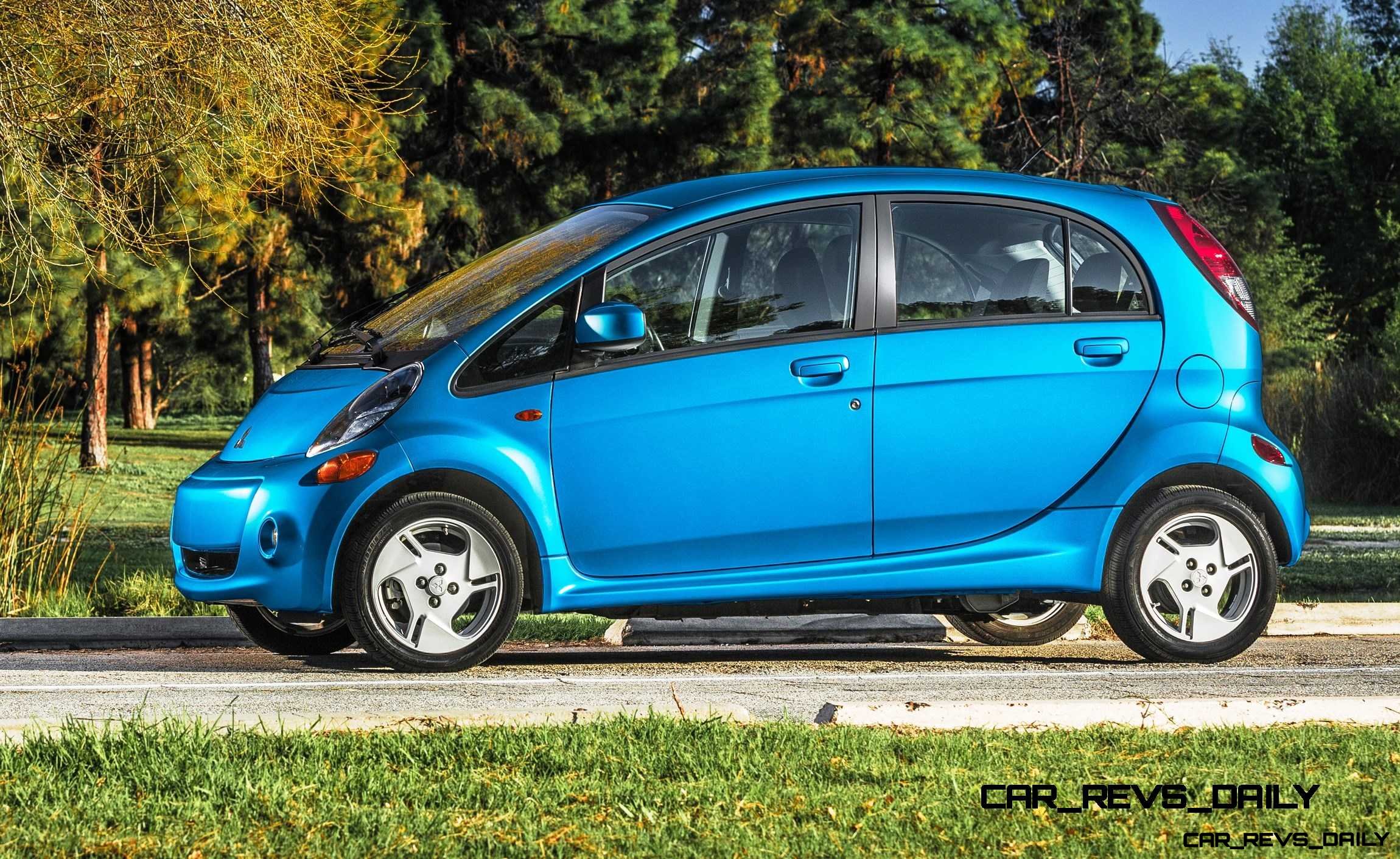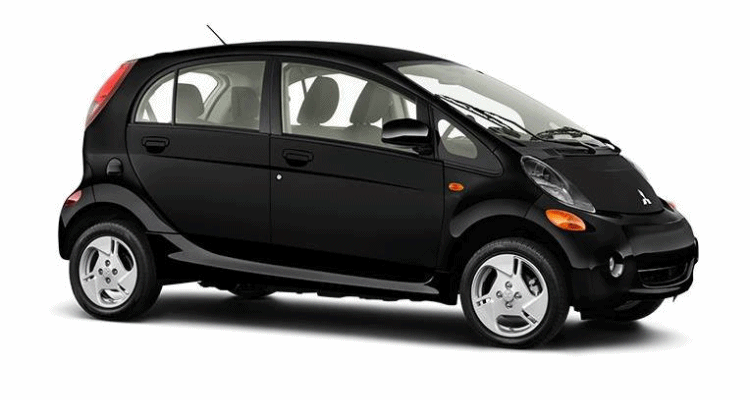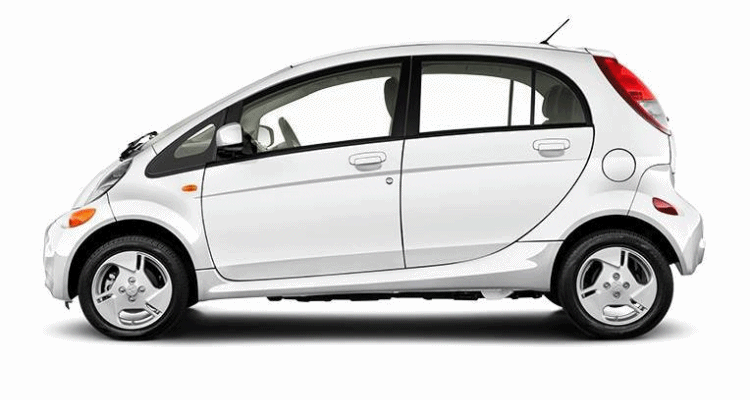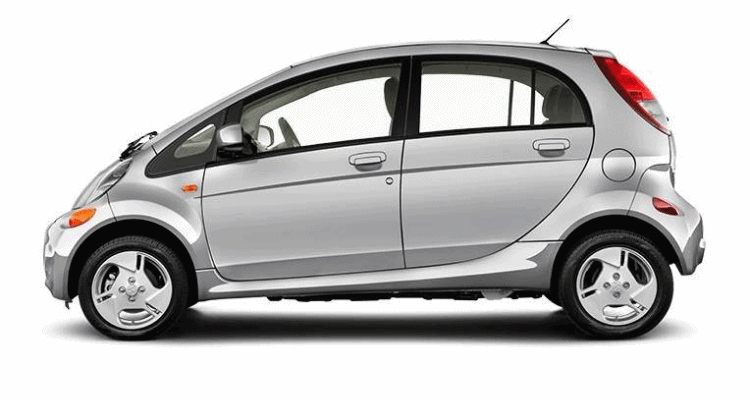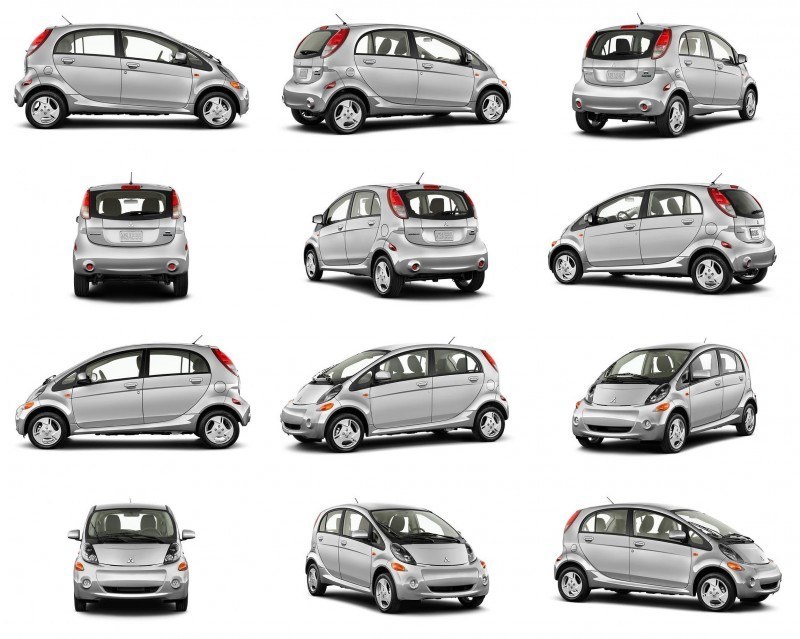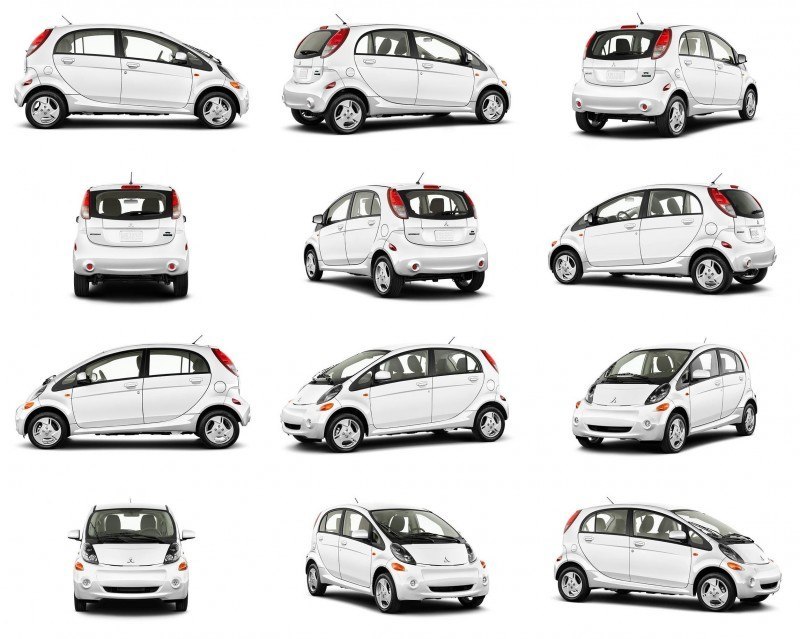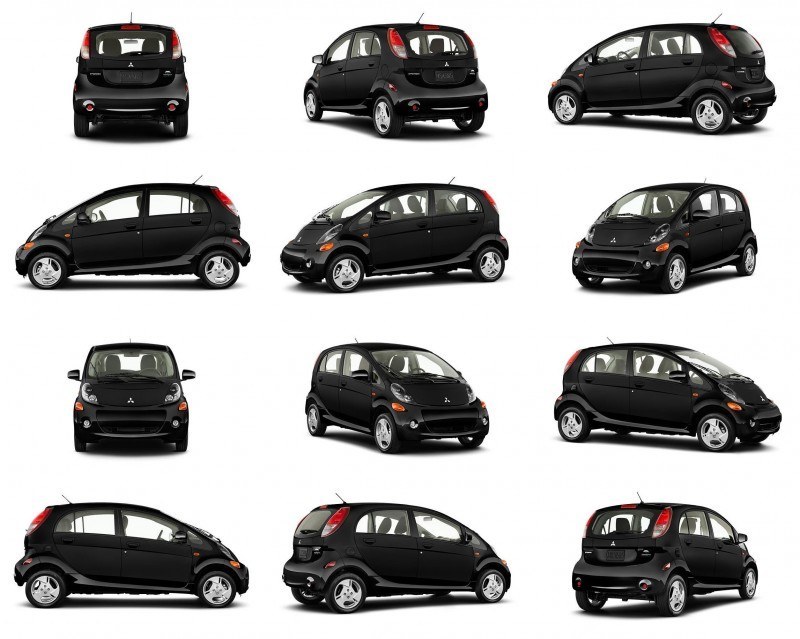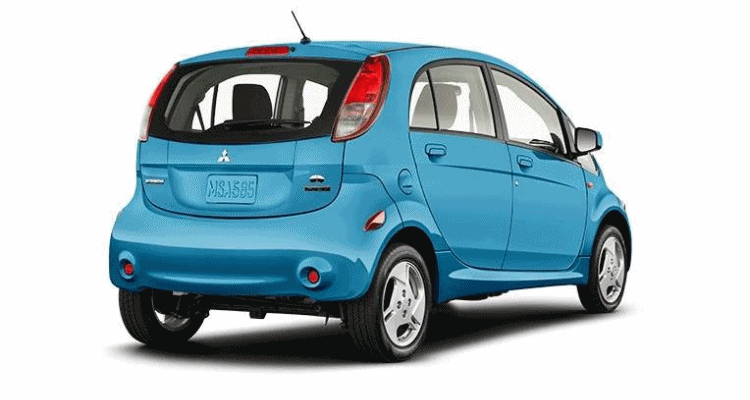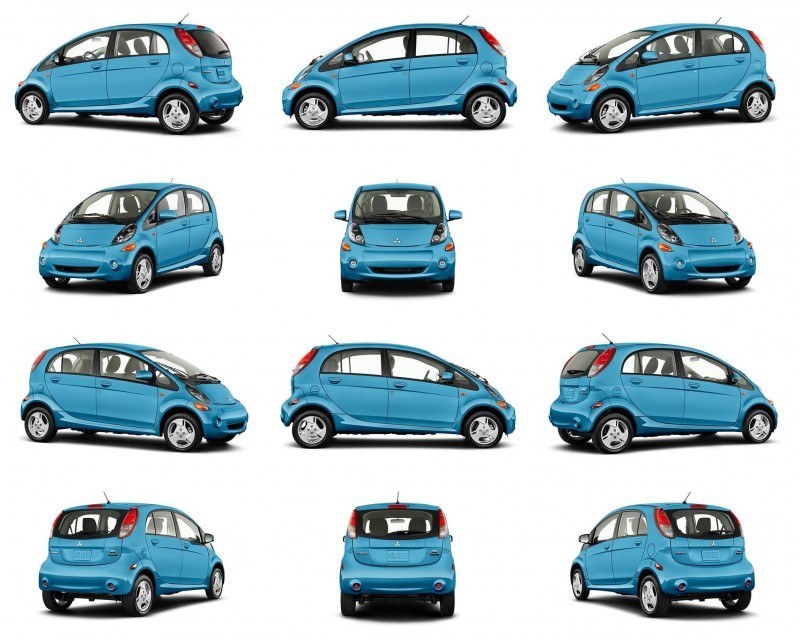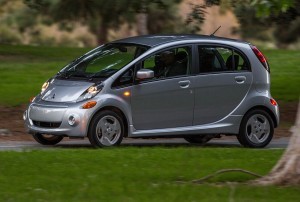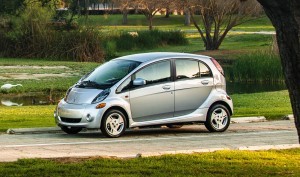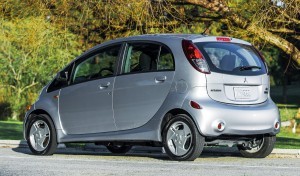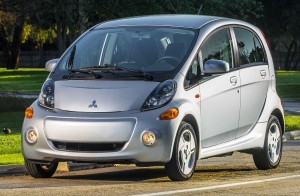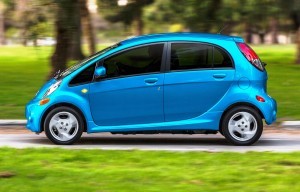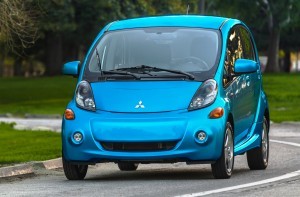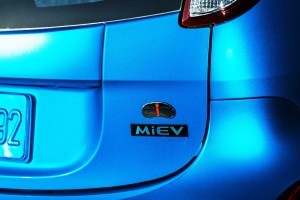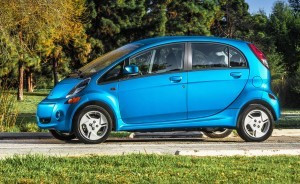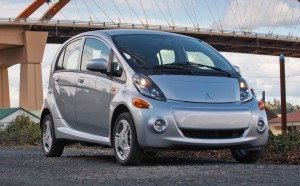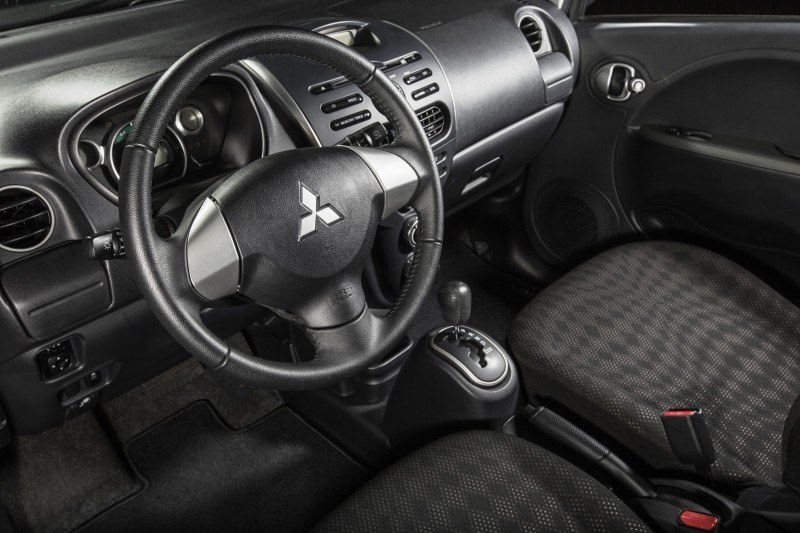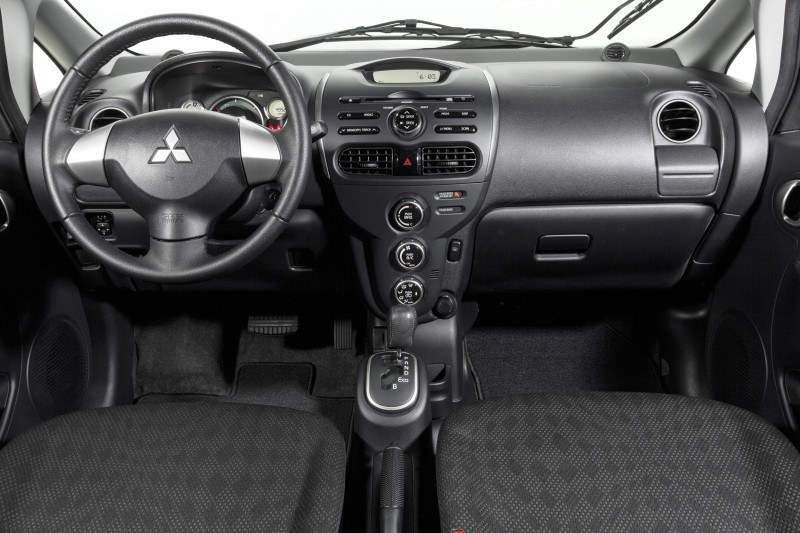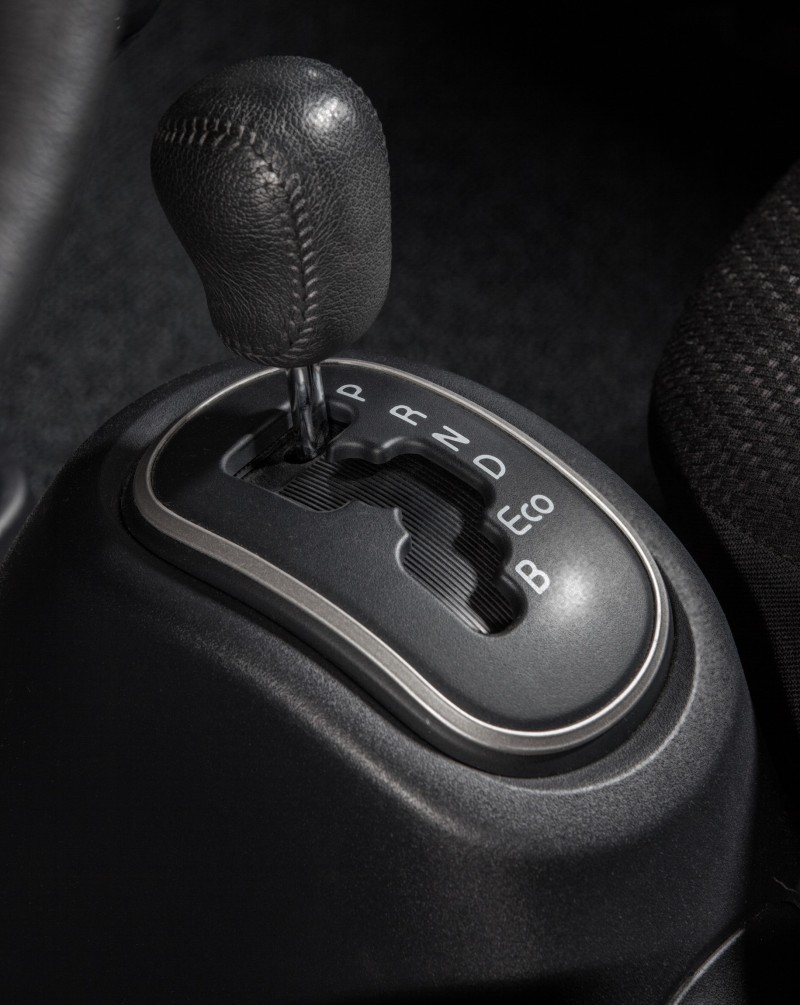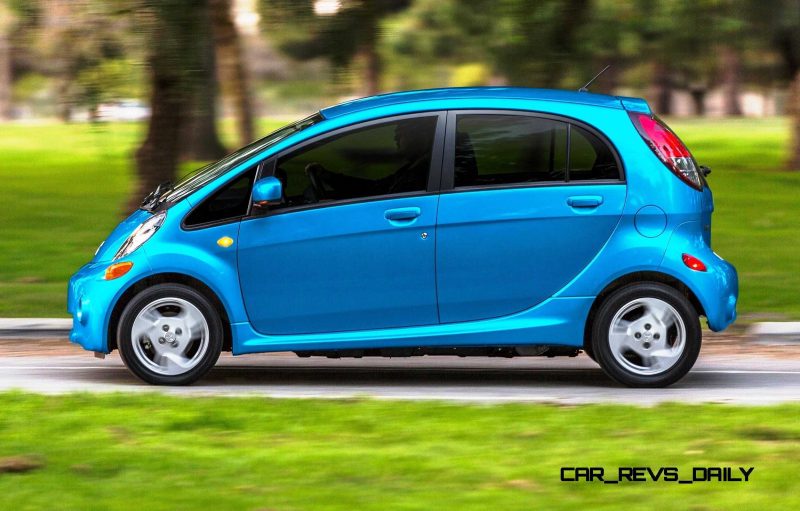The Chevy Bolt concept from Detroit last month made a bit of a splash for promising to be a full-EV five-seater with great utility and a 200-mile battery range for a pre-tax-credit price of around $38,000. Mooted as a Tesla-fighter, the Bolt’s competitive benchmark should actually the innovative Mitsubishi i-MiEV.
This funky city car redefines easy, smooth and pure-electric driving for the masses — with an out-the-door price of just $16,000 after considering the US EPA’s federal tax credit of $7500. That is seriously affordable, and makes the i-MiEV a realistic second-car for city-dwellers. Unlike the $35,000 Nissan Leaf or $42,000 Ford Focus Electric, the i-MiEV does not try to do it all.
This is a purpose-built chassis designed to be ultra-light, extremely safe, and practical inside while also parkable almost anywhere.
Sidebar: We speculate that the safety cell and rear-engine layout was part of a tech licensing and sharing deal during the short-lived Mercedes-Mitsubishi linkup in the mid-2000s, when Mitsu was poised to become the X in DaimlerChrysler’s DCX stock ticker symbol.
Making a rear-engine car safe for crash tests worldwide was extremely challenging, and Mitsu greatly benefits from Mercedes’ billion-dollar R&D investment in the Smartcar program.
The i-MiEV therefore brings cool and cutting edge tech – uncompromised from before day one like almost all other EVs.
To suit American side-impact safety standards and roominess demands, the US-market i-MiEV is nearly a half-foot wider than its Japanese-market sibling.
This helps its style, cabin space and best of all: its rear-drive handling. No other EV except the Tesla Model S has a rear-engine, rear-drive design with a flat and low li-ion battery keeping the handling planted at all times.
The i-MiEV’s 135-pound-feet of torque is more impressive-sounding than its 66-horsepower, but performance is respectable. About 12.8-seconds to 60-mph feels much quicker inside thanks to a speedy 0-40-mph urge that tapers off as speed builds.
The 16 kWh battery-pack is good for at least 60 miles on a charge, with up to 100-miles possible in the right conditions.
Is it right for everyone’s car needs? No. But for those spending $200 a month on ZipCar’s to go to CostCo and Target, like we previously did in Chicago, will find a helpful and extremely affordable EV available for about the same monthly price.
The big news for 2016 is a new seven-inch touchscreen nav option, adding $2000 to the total cost. Ballpark $25,000 as the MSRP, dropping to $17,500 in net terms after tax rebates, add in bonus EV karma points — and you have a winner!
2016 Mitsubishi i-MiEV COLORS
2016 Mitsubishi i-MiEV
2016 Mitsubishi i-MiEV: Most Affordable Electric Vehicle in America
The 2016 Mitsubishi i-MiEV is the most affordably-priced 100 percent electric-powered production vehicle available in America today with a MRSP of $22,9951. A Federal tax credit of $7,500 is available, reducing the net MSRP to only $15,4952, and many states offer additional tax credits/rebates toward the purchase of an electric vehicle (EV) which can further reduce the cost.
New for 2016: Navigation Package
New for the 2016 Mitsubishi i-MiEV is an optional Navigation Package that includes an MMCS navigation system with 7-in. touchscreen display, real-time traffic, 3D mapping and Mapcare®; Bluetooth® hands-free phone system; USB port and rear view camera.
The 2016 Mitsubishi i-MiEV comes equipped with the following standard features:
Interior
- Leather-wrapped steering wheel and shift knob
- Driver and front passenger heated seats
- 6 speaker 100-watt AM/FM/CD audio system with MP3/WMA
- Electric manual air conditioning with micron filter
- Electric compressor cabin heating
- Remote keyless entry
- Power windows, side view mirrors and door locks
- 50/50-split fold-down and recline rear seats
- Passenger-side vanity mirror with lid
- Numerous color/trim upgrades
Exterior
- Aluminum wheels
- Heated side view mirrors
- Front fog lights
- Rear LED combination tail lights
- Daytime running lights
- Black-out door sash trim



Safety
- Advanced air bag system with dual-stage supplemental air bags
- Driver and front-passenger seat-mounted side-impact supplemental air bags
- Roof-mounted curtain side-impact air bags for front and rear-seat outboard occupant protection
- Antilock braking system (ABS) with Electronic Brake-force Distribution (EBD), Brake Assist (BA) and brake override system
- Active Stability Control (ASC) with Traction Control Logic (TCL)
- High voltage cut-off system
- Engine immobilizer anti-theft system
- Approaching Vehicle Audio System (AVAS) for alerting pedestrians
Technology
- 8A/12A switchable Level 1 charging cable
- CHAdeMO DC quick charge port
- Battery warming system
- MiEV remote system (pre-activated air conditioning, heater and timer battery charging)
- Approaching Vehicle Audio System (AVAS) for alerting pedestrians
- Charging Times: 3
- 22 hours for 8amp
- 14 hours for 12 amp
- 7 hours with 240V/15A Level 2 charging system
- Less than 30 minutes to 80% full with CHAdeMO Level 3 DC Quick Charger
- Driving Modes:
- “D” – allows maximum performance as it generates 100% torque in direct response to accelerator input
- “ECO” – helps maximize energy usage (“fuel economy”) by slightly reducing overall power output to reduce the rate of battery consumption
- “B” – increases regenerative brake biasing to augment energy recycling (with 100% of power production available)
Warranty:
- 5 year/60,000 mile powertrain limited warranty
- 8 year/100,000 mile main drive lithium-ion battery limited warranty
- 3 year/36,000 mile new vehicle limited warranty
MiEV Drivetrain – Smooth and Efficient
The Mitsubishi i-MiEV is rated by the EPA to attain 126 mpg equivalency (MPGe) in city driving, 99 MPGe in highway driving and 112 MPGe combined, and achieves a “real world” EPA driving range of 62 miles and 98 miles in the EPA LA4 city cycle unadjusted.
- The “real world” EPA driving evaluation test incorporates battery-sapping segments of aggressive driving and operating the vehicle in higher ambient temperatures with the car’s air conditioning on.
- In the EPA’s LA4 city cycle test, the vehicle is driven approximately 7.5 miles with numerous brief stops along the way; this more accurately mimics in-town driving with its accompanying stops/starts for traffic signals.
Weighing 108 lbs., the electric motor powering the i-MiEV utilizes a synchronous permanent magnetic motor design, allowing for reduced weight and compact size. Electric motor reliability is also improved through the use of an advanced neodymium magnet – the strongest type of permanent magnet for use in an electric motor-powered production car.
Producing nearly 49 kW (66 bhp) at 3000 to 6000 rpm and 196 Nm (145 lb.-ft.) of torque from 1 to 300 rpm, the 2016 Mitsubishi i-MiEV accelerates quickly because maximum torque output is available at any rpm.
The operation of the electric drivetrain is smooth and quiet, and Mitsubishi Motors engineers have designed a special mounting system for the electric motor for an even greater reduction of unwanted noise, vibration and harshness (NVH). The motor mounts for the electric motor include a pair of dual insulators that have been developed to minimize vibration where the mount connects to the chassis by cutting off high-frequency noise produced by the electric motor.
Like the electric motor, the single-speed transmission is also compact, measuring less than 7 in. in length and weighing less than 42 lbs. When mated to the electric motor, the combined transmission/motor measures less than 19 in. long and weighs 143 lbs. – a fraction of the weight of the typical internal combustion engine and transmission pairing.
The Motor Control Unit (MCU) is a critical component of a 100 percent electric-powered vehicle as it manages and regulates the electrical power supply to the electric motor to generate the necessary level of torque to power the vehicle by converting the battery pack’s DC voltage into three-phase AC. Conversely, the MCU is responsible for managing the electrical energy that is produced by the regenerative braking system and is fed back into the lithium-ion battery pack. The Motor Control Unit measures 11.3 in. wide, 12.2 in. long and 6.7 in. high and weighs 33 lbs. Like the lithium-ion main drive battery pack, the MCU is housed in a strong and waterproof/dustproof structure for maximum protection.
Lithium-ion Main Drive Battery Pack
Consisting of 88 individual battery cells, the lithium-ion main drive battery pack’s total energy storage capacity is 16 kWh. The battery pack is sandwiched between the vehicle’s interior floor (sub-floor) and the chassis (body frame) inside a specially-designed stainless-steel protective battery case. This design not only helps to protect the battery pack in an accident but also minimizes penetration of objects/debris that can be picked up from the road surface while driving. Additionally, this support structure also contributes to the vehicle’s structural rigidity as it is bolted directly onto the chassis. Another benefit of the lithium-ion main drive battery pack’s location is that it aids overall vehicle dynamics, handling and stability by lowering the vehicle’s center of gravity.
Well-Engineered i-MiEV Platform
The Mitsubishi i-MiEV electric vehicle is a global car sold in a variety of geographic markets around the world, and numerous design enhancements have been made to the vehicle to better suit the American automotive consumer.
The suspension system – a MacPherson strut layout up front and a 3-link De dion type at the rear – provides increased handling stability, and the updated rear suspension has been modified accept wider tread tires.
Another design improvement for North America is an increase in interior room – the interior cabin width is about 4.5 inches greater when compared to that of the European-spec car.
Regenerative Brake Control
The goal of the Regenerative Brake Control system is to provide the maximum amount of regenerative energy back into the lithium-ion main drive battery pack in a controlled and efficient manner.
The system calculates the torque level from the electric motor based on the shift lever position (D, Eco, or B), and the accelerator and brake pedal positions. Data from the anti-lock braking system (ABS), the battery management unit (BMU), the inverter and the Motor Control Unit (MCU) are also factored into the equation to help optimize torque levels.
The driver can see a visual metric while the Regenerative Brake Control system is at work simply by glancing at the “Charge/Eco” needle gauge at the upper left hand section of the speedometer readout. The needle will drift down into “Charge” under braking and regenerate energy back into the battery pack while the needle will move up into “Eco” when discharging power under acceleration.
Innovative i-MiEV Safety Technologies
Electric vehicle-specific safety technologies include the Approaching Vehicle Audio System (AVAS) external audible alert system to warn pedestrians of the approaching EV; automated electrical disengagement of the electric drivetrain and lithium-ion main drive battery pack to protect the vehicle’s occupants and paramedics/rescue personnel in the event of a collision; and having all high-voltage wiring and componentry positioned between the passenger compartment subfloor and the vehicle’s exterior floors so there are no high-voltage wiring harnesses running through the vehicle’s cabin.
A High Voltage Control System instantaneously shuts down the lithium-ion main drive battery pack’s high-voltage circuitry if the system detects any battery pack leakage or failure (the most likely cause of such a battery failure would be a severe vehicle collision). For an additional level of protection, a specially-designed supplemental G-force sensor will activate and shut down the lithium-ion main drive battery pack’s high voltage circuit should the force of a collision be so severe that it damages the High Voltage Control System.
Additionally, Mitsubishi Motors innovative and patented RISE (Reinforced Impact Safety Evolution) energy absorbing safety cell technology has been incorporated to help reduce injury to the i-MiEV’s occupants.
1 Manufacturer’s Suggested Retail Price. Excludes destination/handling, tax, title, license etc. Retailer price, terms and vehicle availability may vary. See your Mitsubishi retailer for details
2 Tax savings subject to rules and availability. Taxpayer must incur federal tax liability to receive full benefit. Consult your tax professional. Actual prices set by retailer.Financial incentives vary from state to state and are subject to change. Check for availability.
3 Charging times can vary due to the main drive lithium-ion battery pack temperature and conditions.


 http://www.mitsubishicars.com/imiev
http://www.mitsubishicars.com/imiev

Tom Burkart is the founder and managing editor of Car-Revs-Daily.com, an innovative and rapidly-expanding automotive news magazine.
He holds a Journalism JBA degree from the University of Wisconsin – Madison. Tom currently resides in Charleston, South Carolina with his two amazing dogs, Drake and Tank.
Mr. Burkart is available for all questions and concerns by email Tom(at)car-revs-daily.com.

